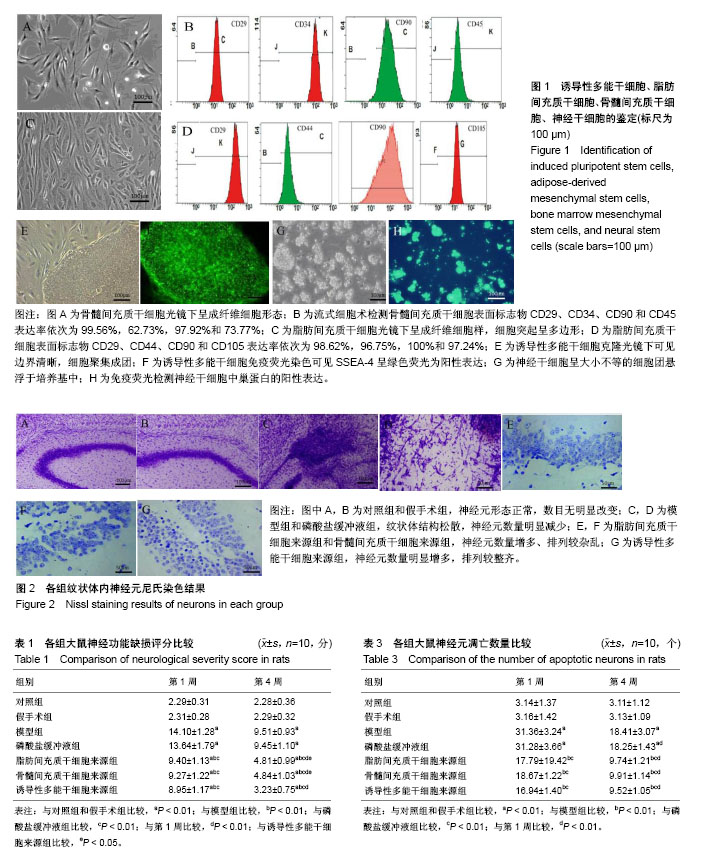| [1] 王晓平,倪京满. 脑缺血再灌注损伤的研究及药物治疗进展[J]. 中国新药杂志,2016,25(6):659-663.[2] 刘婕,张国华.脐血干细胞治疗脑卒中的作用与机制[J].中国组织工程研究,2017,21(9):1472-1476.[3] Andreopoulou E, Arampatzis A, Patsoni M, et al. Being a Neural Stem Cell: A Matter of Character But Defined by the Microenvironment. Adv Exp Med Biol. 2017;1041:81-118.[4] 刘一民,赵艳艳,陈红兵. 神经干细胞移植脑缺血模型大鼠神经细胞凋亡、分化及神经行为学的变化[J].中国组织工程研究, 2017,21(13):2029-2035.[5] Augestad IL, Nyman AKG, Costa AI, et al. Effects of Neural Stem Cell and Olfactory Ensheathing Cell Co-transplants on Tissue Remodelling After Transient Focal Cerebral Ischemia in the Adult Rat. Neurochem Res. 2017;42(6):1599-1609.[6] 钱晓丹,罗春霞,朱东亚.神经干细胞移植研究进展[J].中国细胞生物学学报,2012,34(3):212-217.[7] 李峰,蔡光先.脑缺血后神经再生及其治疗的研究进展[J].中华中医药杂志,2016,31(2):578-581.[8] 曲艺,孙正巍,杨东波,等. 神经干细胞移植治疗大鼠局灶性脑缺血损伤[J].中国组织工程研究,2013,17(10):1876-1883.[9] 冯年花,谢安,娄远蕾,等.人诱导性多能干细胞定向分化为神经干细胞的实验研究[J].基础医学与临床, 2010,30(12):1263-1267.[10] 魏雁,陈刚.神经干细胞工程化的研究进展[J].中国组织工程研究, 2009,13(6):1159-1162.[11] Ryu S, Lee SH, Kim SU, et al. Human neural stem cells promote proliferation of endogenous neural stem cells and enhance angiogenesis in ischemic rat brain. Neural Regen Res. 2016;11(2):298-304.[12] Watanabe T, Nagai A, Sheikh AM, et al. A human neural stem cell line provides neuroprotection and improves neurological performance by early intervention of neuroinflammatory system. Brain Res. 2016;1631:194-203.[13] 蒲晓姝,果磊,张敏珠,等.大鼠骨髓间充质干细胞的培养鉴定以及向神经干细胞分化的实验研究[J].重庆医科大学学报, 2013, 38(3):235-239.[14] 曲泽澎,管圆,崔璐,等.大鼠诱导性多能干细胞向神经前体细胞诱导分化研究[J].同济大学学报:医学版, 2013,34(3):1-6,11.[15] 陈旭东,范文娟,袁科理,等.不同培养条件对小鼠诱导性多能干细胞分化为神经元样细胞的影响[J].细胞与分子免疫学杂志, 2015, 31(9):1216-1223.[16] An J, Yan H, Li X, et al. The inhibiting effect of neural stem cells on proliferation and invasion of glioma cells. Oncotarget. 2017;8(44):76949-76960.[17] Cheng Q, Zhang Z, Zhang S, et al. Human umbilical cord mesenchymal stem cells protect against ischemic brain injury in mouse by regulating peripheral immunoinflammation. Brain Res. 2015;1594:293-304.[18] Yuan-Hsiang Chang, Abe K, Yokota H, et al. Human induced pluripotent stem cell region recognition in microscopy images using Convolutional Neural Networks. Conf Proc IEEE Eng Med Biol Soc. 2017;2017:4058-4061.[19] Pang AL, Xiong LL, Xia QJ, et al. Neural Stem Cell Transplantation Is Associated with Inhibition of Apoptosis, Bcl-xL Upregulation, and Recovery of Neurological Function in a Rat Model of Traumatic Brain Injury. Cell Transplant. 2017;26(7):1262-1275.[20] Gothié JD, Sébillot A, Luongo C, et al. Adult neural stem cell fate is determined by thyroid hormone activation of mitochondrial metabolism. Mol Metab. 2017;6(11):1551-1561.[21] Huang P, Gebhart N, Richelson E, et al. Mechanism of mesenchymal stem cell-induced neuron recovery and anti-inflammation. Cytotherapy. 2014;16(10):1336-1344.[22] Choi C, Oh SH, Noh JE, et al. Attenuation of Postischemic Genomic Alteration by Mesenchymal Stem Cells: a Microarray Study. Mol Cells. 2016;39(4):337-344.[23] 田胜男,王博,李琦,等.诱导多能干细胞的安全性及应用研究进展[J].中国组织工程研究,2017,21(5):815-820.[24] Lu P, Ceto S, Wang Y, et al. Prolonged human neural stem cell maturation supports recovery in injured rodent CNS. J Clin Invest. 2017;127(9):3287-3299.[25] 杨炎歌,段淑荣.脑梗死后VEGF及bFGF对神经干细胞增殖分化的机制研究进展[J].中国卒中杂志,2016,11(8):704-708.[26] Song S, Park JT, Na JY, et al. Early expressions of hypoxia-inducible factor 1alpha and vascular endothelial growth factor increase the neuronal plasticity of activated endogenous neural stem cells after focal cerebral ischemia. Neural Regen Res. 2014;9(9):912-918.[27] Natalwala A, Kunath T. Preparation, characterization, and banking of clinical-grade cells for neural transplantation: Scale up, fingerprinting, and genomic stability of stem cell lines. Prog Brain Res. 2017;230:133-150.[28] Bulstrode H, Johnstone E, Marques-Torrejon MA, et al. Elevated FOXG1 and SOX2 in glioblastoma enforces neural stem cell identity through transcriptional control of cell cycle and epigenetic regulators. Genes Dev. 2017;31(8):757-773.[29] Gao M, Dong Q, Zhang H, et al. Syringe needle skull penetration reduces brain injuries and secondary inflammation following intracerebral neural stem cell transplantation. Exp Ther Med. 2017;13(3):885-890.[30] Malloy KE, Li J, Choudhury GR, et al. Magnetic Resonance Imaging-Guided Delivery of Neural Stem Cells into the Basal Ganglia of Nonhuman Primates Reveals a Pulsatile Mode of Cell Dispersion. Stem Cells Transl Med. 2017;6(3):877-885.[31] Yaghoobi K. Neural regeneration after spinal cord injury treatment by lavandula angustifolia and human umbilical mesanchymal stem cell transplantation. Neural Regen Res. 2017;12(1):68-69.[32] Marsh SE, Blurton-Jones M. Neural stem cell therapy for neurodegenerative disorders: The role of neurotrophic support. Neurochem Int. 2017;106:94-100.[33] Meneghini V, Frati G, Sala D, et al. Generation of Human Induced Pluripotent Stem Cell-Derived Bona Fide Neural Stem Cells for Ex Vivo Gene Therapy of Metachromatic Leukodystrophy. Stem Cells Transl Med. 2017;6(2):352-368.[34] Ozaki M, Iwanami A, Nagoshi N, et al. Evaluation of the immunogenicity of human iPS cell-derived neural stem/progenitor cells in vitro. Stem Cell Res. 2017;19: 128-138.[35] Srivastava AK, Gross SK, Almad AA, et al. Serial in vivo imaging of transplanted allogeneic neural stem cell survival in a mouse model of amyotrophic lateral sclerosis. Exp Neurol. 2017;289:96-102.[36] Chen NN, Wei F, Wang L, et al. Tumor Necrosis Factor Alpha Induces Neural Stem Cell Apoptosis Through Activating p38 MAPK Pathway. Neurochem Res. 2016;41(11):3052-3062.[37] Bacigaluppi M, Russo GL, Peruzzotti-Jametti L, et al. Neural Stem Cell Transplantation Induces Stroke Recovery by Upregulating Glutamate Transporter GLT-1 in Astrocytes. J Neurosci. 2016;36(41):10529-10544.[38] Eckert A, Huang L, Gonzalez R, et al. Bystander Effect Fuels Human Induced Pluripotent Stem Cell-Derived Neural Stem Cells to Quickly Attenuate Early Stage Neurological Deficits After Stroke. Stem Cells Transl Med. 2015;4(7):841-851.[39] Wang X, Yu X, Xie C, et al. Rescue of Brain Function Using Tunneling Nanotubes Between Neural Stem Cells and Brain Microvascular Endothelial Cells. Mol Neurobiol. 2016;53(4): 2480-2488.[40] Cheng Y, Zhang J, Deng L, et al. Intravenously delivered neural stem cells migrate into ischemic brain, differentiate and improve functional recovery after transient ischemic stroke in adult rats. Int J Clin Exp Pathol. 2015;8(3):2928-2936.[41] Wu MF, Zhang SQ, Gu R, et al. Transplantation of erythropoietin gene-modified neural stem cells improves the repair of injured spinal cord. Neural Regen Res. 2015;10(9): 1483-1490.[42] 梁锐超,方芳.内源性神经干细胞在中枢神经系统创伤修复中的研究进展[J].华西医学,2014,29(1):150-154.[43] 王启征,王丽娟,张雄.脑缺血后神经可塑性的研究进展[J].中华老年心血管病杂志,2017,19(2):217-219. |
.jpg)


.jpg)